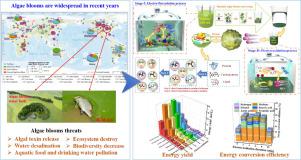Water Research ( IF 11.4 ) Pub Date : 2022-07-31 , DOI: 10.1016/j.watres.2022.118929 Haixing Chang 1 , Haihua Wu 2 , Lei Zhang 2 , Wenbo Wu 2 , Chaofan Zhang 3 , Nianbing Zhong 4 , Dengjie Zhong 2 , Yunlan Xu 2 , Xuefeng He 4 , Jing Yang 2 , Yue Zhang 2 , Ting Zhang 2 , Qiang Liao 5 , Shih-Hsin Ho 3

|
Globally eruptive harmful algal blooms (HABs) have caused numerous negative effects on aquatic ecosystem and human health. Conversion of HABs into biohythane via dark fermentation (DF) is a promising approach to simultaneously cope with environmental and energy issues, but low HABs harvesting efficiency and biohythane productivity severely hinder its application. Here we designed a gradient electro-processing strategy for efficient HABs harvesting and disruption, which had intrinsic advantages of no secondary pollution and high economic feasibility. Firstly, low current density (0.888-4.444 mA/cm2) was supplied to HABs suspension to harvest biomass via electro-flocculation, which achieved 98.59% harvesting efficiency. A mathematic model considering coupling effects of multi-influencing factors on HABs harvesting was constructed to guide large-scale application. Then, the harvested HABs biomass was disrupted via electro-oxidation under higher current density (44.44 mA/cm2) to improve bioavailability for DF. As results, hydrogen and methane yields of 64.46 mL/ (g VS) and 171.82 mL/(g VS) were obtained under 6 min electro-oxidation, along with the highest energy yield (50.1 kJ/L) and energy conversion efficiency (44.87%). Mechanisms of HABs harvesting and disruption under gradient electro-processing were revealed, along with the conversion pathways from HABs to biohythane. Together, this work provides a promising strategy for efficient disposal of HABs with extra benefit of biohythane production.
中文翻译:

具有机理洞察力的梯度电处理策略,可有效地将有害藻华转化为生物乙烷
全球爆发的有害藻华 (HAB) 对水生生态系统和人类健康造成了许多负面影响。通过暗发酵 (DF) 将 HABs 转化为生物乙烷是一种同时应对环境和能源问题的有前景的方法,但低 HABs 收获效率和生物乙烷生产率严重阻碍了其应用。在这里,我们设计了一种用于高效收获和破坏 HAB 的梯度电处理策略,该策略具有无二次污染和高经济可行性的内在优势。首先,低电流密度(0.888-4.444 mA/cm 2) 提供给 HABs 悬浮液,通过电絮凝收获生物质,达到 98.59% 的收获效率。构建了考虑多影响因素对HABs收获的耦合效应的数学模型,以指导大规模应用。然后,收获的HABs生物质在较高电流密度(44.44 mA/cm 2) 以提高 DF 的生物利用度。结果,在电氧化 6 min 下,氢气和甲烷的产率分别为 64.46 mL/(g VS) 和 171.82 mL/(g VS),以及最高的能量产率 (50.1 kJ/L) 和能量转换效率 (44.87) %)。揭示了梯度电处理下 HABs 的收获和破坏机制,以及从 HABs 到生物乙烷的转化途径。总之,这项工作为高效处置 HAB 提供了一种有前景的策略,并具有生物乙烷生产的额外好处。











































 京公网安备 11010802027423号
京公网安备 11010802027423号